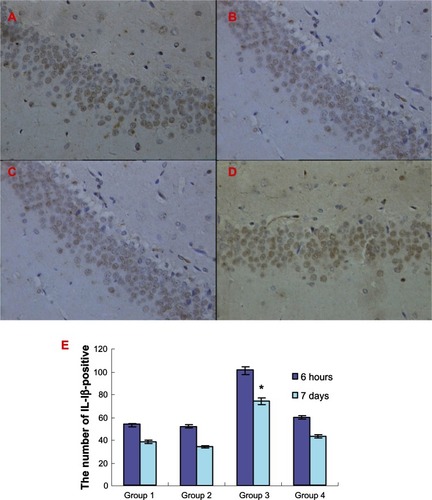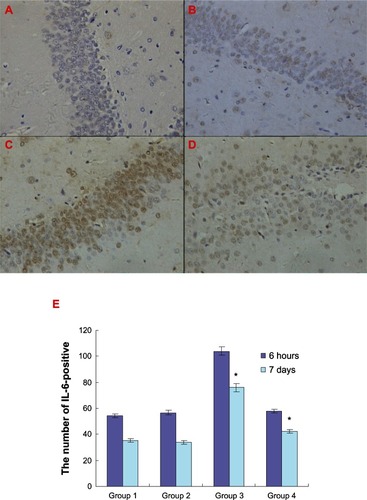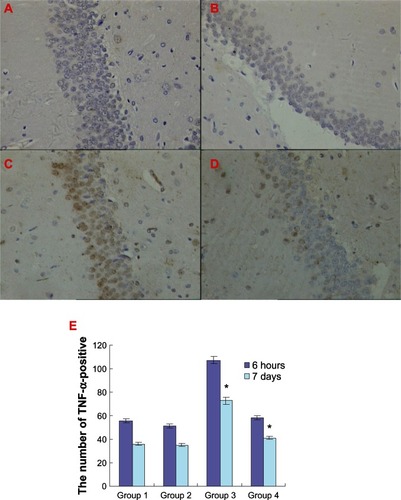Dear editor
Zhang et al have recently published an interesting article in Clinical Interventions in Aging entitled “Atorvastatin attenuates the production of IL-1β, IL-6, and TNF-α in the hippocampus of an amyloid β1-42-induced rat model of Alzheimer’s disease”.Citation1 The conclusion that “IL-1β, IL-6, and TNF-α were significantly decreased in the atorvastatin-treated AD group than that in the AD group” is not justified by the data presented in Figures , , and . Given that the AD group and the atorvastatin-treated AD group showed no significant difference in numbers of cells positive for interleukin-1β, interleukin-6, or tumor necrosis factor-α, and in some cases there may be a trend towards an increase in positive cells in the atorvastatin-treated AD group, it is hard to see how they came to this conclusion.
Figure 3 Atorvastatin attenuated interleukin-1β expression in the hippocampus of a rat treated with Aβ1-42. The upper panel shows interleukin-1β-positive cells in rat hippocampus, detected by immunohistochemistry on day 7 after Aβ injection (original magnification × 400). (A) Control group (group 1), (B) atorvastatin control group (group 2), (C) AD group (group 3), and (D) atorvastatin-treated AD group (group 4). (E) The lower panel shows the number of interleukin-1β-positive cells counted in the rat hippocampus.
Notes: The data are presented as the mean ± standard deviation. *P < 0.01.
Abbreviations: Aβ, amyloid-beta peptide; IL, interleukin; AD, Alzheimer’s disease.

Figure 4 Atorvastatin attenuated interleukin-6 expression in the hippocampus of a rat treated with Aβ 1-42. The upper panel shows interleukin-6-positive cells in rat hippocampus, detected by immunohistochemistry on day 7 after Aβ injection (original magnification × 400). (A) Control group (group 1), (B) atorvastatin control group (group 2), (C) AD group (group 3), and (D) atorvastatin-treated AD group (group 4). (E) The lower panel shows the number of interleukin-6-positive cells counted in the rat hippocampus.
Notes: The data are presented as the mean ± standard deviation. *P < 0.01.
Abbreviations: Aβ, amyloid-beta (peptide); IL, interleukin; AD, Alzheimer’s disease.

Figure 5 Atorvastatin attenuated TNF-α expression in hippocampus of the Aβ1-42-treated rat. The upper panel shows TNF-α-positive cells in rat hippocampus, detected by immunohistochemistry on day 7 after Aβ injection (original magnification × 400). (A) Control group (group 1), (B) atorvastatin control group (group 2), (C) AD group (group 3), and (D) atorvastatin-treated AD group (group 4). (E) The lower panel shows the number of TNF-α-positive cells counted in the rat hippocampus.
Abbreviations: Aβ, amyloid-beta (peptide); IL, interleukin; AD, Alzheimer’s disease; TNF-α, tumor necrosis factor alpha.

In their introduction, Li et al state that “Cholesterol-lowering agents, particularly 3-hydroxy-3-methylglutaryl-coenzyme A (HMG-CoA) reductase inhibitors (also known as statins), have been reported to be capable of increasing the ratio of alpha to beta secretase activity and then increasing the concentrations of extracellular Aβ.”
The conventional wisdom, supported by the references that they cite (eg, Buxbaum et alCitation2), is that changing the ratio in this way is likely to lead to a decrease, not an increase, in extracellular Aβ. I would very much like to hear the authors’ and your views on these issues.
Dear editor
We thank Ms Tait for her interest in our recently published paper in Clinical Interventions in Aging. Regarding the first issue raised, we have checked the original manuscript and raw data of our experiment and found that there is a mis-pairing of the columns for group 2 and group 3 in Figures 3, 4, and 5. Below are the corrected Figures 3E, 4E, and 5E based on the raw data. In these figures, the original column of group 2 has been modified to group 3, and vice versa. From these figures, it is clear that the atorvastatin-treated AD group had a significant reduction in the numbers of cells positive for interleukin-1β, interleukin-6, or tumor necrosis factor-α in the atorvastatin-treated AD group.
We agree about the point concerning “the changing of ratio of alpha to beta secretase is likely to lead to a decrease in extracellular Aβ”. There may be a typographical on this sentence. Thus, the introduction of “Cholesterol-lowering agents, particularly 3-hydroxy-3-methylglutaryl-coenzyme A (HMG-CoA) reductase inhibitors (also known as statins), have been reported to be capable of increasing the ratio of alpha to beta secretase activity and then increasing the concentrations of extracellular Aβ” should be revised to read “Cholesterol-lowering agents, particularly 3-hydroxy-3-methylglutaryl-coenzyme A (HMG-CoA) reductase inhibitors (also known as statins), have been reported to be capable of increasing the ratio of alpha to beta secretase activity and then decreasing the concentrations of extracellular Aβ”. We are grateful for the interest shown in this study.